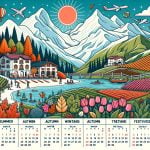Are you wondering what months are bettere to travel to Italy? Look no further. Italy is a country that beckons travelers from around the world with its rich history, art, culture, and of course, exquisite cuisine. From the iconic city of Rome to the romantic canals of Venice and the stunning Amalfi Coast, there is something for everyone in this picturesque Mediterranean destination.
Italy’s diverse landscapes, from mountains to beaches, offer an array of activities and experiences throughout the year. Understanding the climate and knowing when to visit can make or break your Italian vacation. In this article, we will explore the best times to visit Italy based on weather conditions, tourist crowds, budget travel opportunities, cultural events, and insider tips for making the most of your trip.
Whether you are a history enthusiast eager to explore ancient ruins or a food lover craving authentic pasta and gelato experiences, Italy has it all. So get ready to plan your dream Italian vacation as we guide you through the best months to visit this must-see European destination. Whether you’re seeking vibrant spring blooms or crisp autumn air, Italy offers unique experiences all year round.
Weather Overview
Italy is a diverse country with a range of climates, making it an ideal destination for travelers year-round. Understanding the weather patterns in different regions of Italy can help visitors plan their trips more effectively.
Here’s an overview of the climate in Italy:
- Northern Italy: The region experiences hot summers and cold winters, with occasional snowfall in the mountainous areas. Rainfall is evenly distributed throughout the year.
- Central Italy: Summers are hot and dry, while winters are mild and wet. The coastal areas have a Mediterranean climate, while the inland areas have a more continental climate.
- Southern Italy and Islands: With its Mediterranean climate, this region enjoys hot, dry summers and mild, wet winters. The southernmost parts of Italy rarely experience snowfall.
Considering this weather overview, travelers can choose what months are bettere to travel to Italy based on their preferred climate and activities. Whether it’s basking in the summer sun on the Amalfi Coast or enjoying winter sports in the Italian Alps, there’s something for everyone in every season.
Peak Tourist Season
When planning a trip to Italy, it is essential to consider the peak tourist season. This period, usually from June to August, is characterized by large crowds, long lines at popular attractions, and high accommodation prices. If you prefer a more relaxed and budget-friendly experience, it may be best to avoid visiting during these months.
During the peak tourist season in Italy, popular cities like Rome, Florence, and Venice can become overcrowded with tourists. Attractions such as the Colosseum and the Vatican Museums are often filled with long queues, making it challenging to fully enjoy the experience. Additionally, hotel rates tend to skyrocket during this time, putting a strain on travelers’ budgets.
For those looking to avoid the hustle and bustle of peak tourist season, it is advisable to plan a trip outside of the months of June through August. Visiting in May or September offers milder weather while still avoiding the large crowds. Not only will you have a more peaceful experience at famous landmarks and attractions but you will also find better deals on accommodations and even airfare during these off-peak months.
To further avoid the peak tourist season and make the most of your Italian vacation, consider visiting during the shoulder months of April or October. During these times, you can benefit from pleasant weather and fewer crowds while exploring Italy’s beautiful cities and countryside.
- Consider traveling between April-May or September-October
- Research local festivals and events happening during your visit
- Book accommodations in advance for better deals
Off-Peak Season
Italy’s off-peak season, also known as the shoulder months, presents travelers with a unique and rewarding experience. The shoulder months in Italy typically fall between April to May and September to October. During these times, the weather is generally mild and pleasant, making it ideal for outdoor activities and sightseeing without having to battle large crowds of tourists.
One of the hidden benefits of traveling during the off-peak season is the opportunity to immerse yourself in authentic Italian culture. With fewer tourists around, you’ll have a chance to interact with locals on a more personal level and gain a deeper understanding of Italian way of life. Additionally, visiting popular attractions during these months means shorter wait times and more intimate experiences.
Moreover, traveling during the shoulder months can also be more budget-friendly. With decreased demand for accommodations and tour packages, travelers can often find better deals and discounts on flights, hotels, and activities. This allows visitors to make the most out of their trip without breaking the bank.
| Shoulder Months | Benefits |
|---|---|
| April – May | Mild weather, fewer crowds, cultural immersion, budget-friendly options |
| September – October | Pleasant climate, intimate experiences at popular attractions, cost-effective travel |
Festivals and Events
Italy is not only renowned for its stunning landscapes and delicious cuisine, but it is also a country that celebrates its culture through various festivals and events throughout the year. From religious processions to colorful carnivals, Italy offers a myriad of cultural experiences that are definitely worth experiencing. When planning a trip to Italy, it’s important to consider the timing of these festivals and events to enhance your travel experience.
Spring Festivals
Spring in Italy is a time for many religious festivals and events, making it a great time to visit if you’re interested in witnessing traditional celebrations. One of the most famous spring events is Easter, which is celebrated with great fervor across the country. Cities like Rome, Florence, and Sicily host elaborate processions and religious ceremonies that offer an insight into Italian traditions.
Summer Carnivals
If you’re looking for lively and colorful celebrations, visiting Italy during the summer months is ideal as this is when many cities hold their annual carnivals. Venice hosts the famous Carnival of Venice, known for its extravagant masks and costumes. Additionally, cities like Palermo and Viareggio also host lively summer carnivals featuring parades, music, and street performances.
Autumn Harvest Festivals
Autumn brings a different kind of cultural experience in Italy with the celebration of harvest festivals known as “sagras.” These festivals are dedicated to showcasing and savoring Italy’s abundant food produce such as truffles, wine, chestnuts, olives, and more. The Alba White Truffle Festival in Piedmont or the Olive Oil Festival in Tuscany are just some examples of these autumn harvest celebrations.
Knowing when these festivals take place can help you plan your trip to ensure you don’t miss out on these unique cultural experiences in Italy. Whether you want to witness traditional religious processions or partake in vibrant summer carnivals, each season offers something special for travelers seeking an authentic taste of Italian culture.
Budget Travel
Traveling to Italy on a budget is possible, especially if you know when to go. Finding deals and discounts during certain months can make a significant difference in the overall cost of your trip. Whether you’re looking for cheap flights, affordable accommodations, or discounted activities, understanding the best times to travel to Italy can help you save money without sacrificing the quality of your experience.
Off-Peak Months: A Budget Traveler’s Paradise
The off-peak months in Italy, typically considered to be November to March, are ideal for budget travelers. During this time, airfare and accommodation prices tend to drop significantly compared to the peak tourist season.
Additionally, many attractions and tour operators offer discounts and promotions to attract visitors during the quieter months. Traveling during the off-peak season not only allows you to save money but also provides a more authentic and less crowded experience as you explore Italy’s famous landmarks and hidden gems.
Shoulder Months: The Perfect Balance
The shoulder months of April and October are also great for budget travelers. During these transitional periods between peak and off-peak seasons, you can take advantage of lower prices while still enjoying pleasant weather and relatively fewer crowds. In April, as spring blooms across the country, you can find some excellent deals before the summer rush begins. Similarly, October offers mild temperatures and beautiful fall foliage, making it an attractive time for budget-conscious travelers to visit Italy.
By choosing the right months for your Italian adventure, you can make the most of your travel budget without compromising on experiencing all that this stunning country has to offer. Whether you’re exploring historic cities, indulging in delectable cuisine, or soaking up the natural beauty of Italy’s landscapes, timing your trip effectively can result in significant savings without skimping on enjoyment or cultural immersion.
Outdoor Activities
Italy offers an array of outdoor activities to suit every type of traveler, from hiking in the Dolomites to sunbathing on the Amalfi Coast. The best time to enjoy these outdoor activities largely depends on the season.
During the summer months, from June to August, Italy experiences warm and sunny weather, making it the perfect time for beach vacations and water sports along the country’s stunning coastline. This is also an ideal time for hiking and mountain biking in the Italian Alps or exploring the picturesque countryside. However, it’s worth noting that popular tourist destinations can be crowded during this time, especially in August when many locals take their own vacations.
In contrast, the fall season, from September to November, offers cooler temperatures and colorful foliage, making it a great time for outdoor pursuits such as wine tasting in Tuscany or exploring the rural landscapes of Umbria. Additionally, this season sees fewer tourists and lower accommodation prices compared to the summer months.
For those interested in winter sports, Italy’s ski resorts come alive from December to February with excellent snow conditions and numerous winter sports options such as skiing, snowboarding, and snowshoeing. The Dolomites and the Alps offer world-class skiing opportunities while providing stunning scenery for nature enthusiasts.
Ultimately, each season offers its own unique opportunities for outdoor activities in Italy. Travelers should consider their preferred outdoor pursuits and seasonal weather conditions when planning their visit to make the most of Italy’s natural beauty throughout the year.
Insider Tips
When planning a trip to Italy, it’s important to consider the dos and don’ts for traveling in different months. Each season offers unique experiences and challenges, so being prepared is key to making the most of your Italian vacation.
In the peak tourist season, which typically spans from June to August, it’s important to book accommodations and popular attractions well in advance. The crowds can be overwhelming, especially in cities like Rome, Florence, and Venice. Additionally, the scorching heat can make sightseeing uncomfortable, so be sure to pack sunscreen and stay hydrated. Don’t forget that this is also when prices are at their highest due to high demand.
Traveling in the shoulder months of April-May or September-October can offer a more enjoyable experience with fewer crowds and milder weather. However, it’s important to be aware that some attractions may have reduced hours or be closed altogether during these off-peak times. It’s also wise to pack layers for cooler evenings and occasional rain showers.
During the winter months of November-February, many coastal towns and islands shut down or operate on limited schedules. However, this is a great time to explore cities like Milan or Turin without the summer crowds. Just be prepared for chilly weather and shorter daylight hours. And don’t expect all tourist amenities to be available as some businesses may close for the season.
Overall, each month offers its own pros and cons for traveling in Italy. Understanding what each season brings will help you make an informed decision on when to visit based on your preferences for weather, crowd levels, and available activities.
Conclusion
In conclusion, Italy is a remarkable travel destination that offers something for every type of traveler. Whether you are interested in historical landmarks, stunning art, delicious cuisine, or beautiful landscapes, Italy has it all. However, when planning your dream Italian vacation, it’s essential to consider the best month to visit based on your preferences and priorities.
While peak tourist season in Italy typically falls between the months of June and August, it’s important to note that these months also mean higher prices, larger crowds, and intense heat. Therefore, if you prefer a more relaxed atmosphere with mild weather and fewer tourists, considering visiting during the shoulder months such as May or September. These off-peak months offer hidden benefits such as cheaper accommodations, shorter lines at attractions, and a more authentic experience of Italian culture.
Additionally, if you are interested in experiencing Italy’s vibrant festivals and events or engaging in outdoor activities such as hiking or skiing in the mountains, certain months may be more suitable for your interests. Ultimately, the best month to travel to Italy depends on what you want to get out of your vacation experience. By carefully considering the factors and insider tips mentioned in this article, you can choose the perfect time for your dream Italian getaway.
Frequently Asked Questions
What Is the Best Month to Visit Italy?
The best month to visit Italy is generally considered to be May. During this time, the weather is mild and pleasant, and the tourist crowds are not as overwhelming as they can be during peak summer months.
What Is the Cheapest Month to Go to Italy?
The cheapest month to go to Italy is typically November. This is when you can find lower airfares and hotel prices due to it being an off-peak travel season. However, do keep in mind that some attractions and restaurants may have reduced operating hours or be closed.
What Month Has the Least Tourists in Italy?
If you want to avoid crowds, consider visiting Italy in January or February. These months tend to have the fewest tourists, giving you a more authentic experience of Italian culture and allowing you to visit popular attractions without long lines or overcrowding.

I’m a passionate traveler, writer, and Italophile. My fascination with Italy’s history, art, and culture has led me on countless adventures across the Italian landscape. Through “I Live Italy,” I share my love for this extraordinary country and aims to inspire others to explore its boundless beauty.





